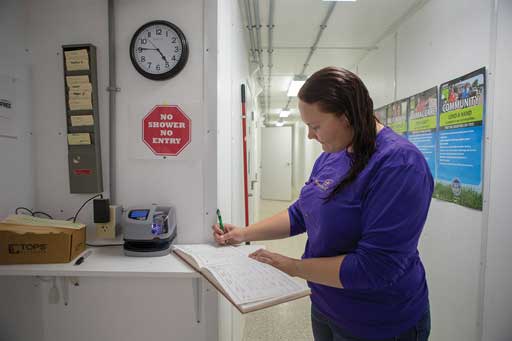
Research funded by the Swine Health Information Center (SHIC) found significant biosecurity gaps in wean-to-finish facilities after placement, specifically regarding potential porcine reproductive and respiratory syndrome (PRRS) virus, porcine epidemic diarrhea (PED) virus, and Actinobacillus pleuropneumoniae transmission.1 Additionally, aggregated data from the SHIC-funded Swine Disease Monitoring Report shows breeding herd outbreaks of PRRS virus tend to follow outbreaks in wean-to-finish sites. These breaks escalate up the supply chain with losses estimated to be $664 million2 for PRRS virus coupled with supply and demand implications for PED virus.3 The onset of emerging and endemic animal health concerns is being proactively addressed with the producer- and veterinarian-led Wean-to-Harvest Biosecurity Program initiated by SHIC.
“By leveraging funds together with Pork Checkoff and the Foundation for Food & Agriculture Research for this program, SHIC has funded a wide range of diverse research projects that will enable the pork industry to consider biosecurity in novel and unconventional ways,” remarked Dr Megan Niederwerder, SHIC executive director. “These projects are trying to solve the biosecurity gap that results in higher prevalence of endemic diseases such as PED and PRRS in the wean-to-harvest phases of pork production. Addressing this gap lessens disease pressure across all phases of production and provides value to the whole industry.”
Research outcomes from the inaugural 2-year program are beginning to be shared. In all, the 16 projects funded in 2023 have laid a solid foundation for future advancements in swine health management.
Five additional projects (listed in sidebar) prioritize on-site and transportation biosecurity in five targeted areas in the second round of funding.4 The priority areas include:
- personnel biocontainment and bio-exclusion;
- mortality management;
- truck wash efficiency;
- alternatives to a fixed truck wash; and
- packing plant biocontainment.
The collaborative proposals define practices and investigate technologies and protocols to improve biosecurity. Herd health status monitoring can demonstrate success while evaluating the solution’s affordability, efficiency, and practicality. Specific details about each priority can be found at swinehealth.org.
In essence, biosecurity is not merely about filling gaps; it is about constructing robust bridges in animal care, grounded in practicality and research. “Biosecurity is one of the most important lines of defense against disease for producers and veterinarians,” says Dr Marisa Rotolo, director of swine health at the National Pork Board. “As an industry, it is vitally important we continue to evaluate and improve our biosecurity protocols across all phases of production, especially wean-to-harvest. Veterinarians can reduce the risk of disease and improve herd health by staying up to date on this program and the research it invests in to advance our understanding of effective biosecurity.”
While industry-wide initiatives are instrumental, Rotolo says veterinarians can make an immediate impact by assisting farmers in implementing a Secure Pork Supply plan, which includes an enhanced site-specific biosecurity plan. Resources to help develop these plans can be found at securepork.org.
Other practical examples of biosecurity include requiring sign-in sheets; identifying perimeters and lines of separation; and providing proper footwear, shoe covers and clothing. More extensive changes could include using ultraviolet boxes, implementing a Danish entry, and installing showers. A self-assessment checklist for enhanced biosecurity for animals raised indoors is available at securepork.org, in addition to training videos and signs to hang near barns.
As results from the second round of the program are in progress, the industry anticipates a future where comprehensive biosecurity practices significantly enhance the resilience of swine production systems.
References
*1. SHIC-funded project examines growing pig site biosecurity gaps. Swine Health Information Center. June 16, 2022. Accessed January 18, 2024. https://www.swinehealth.org/shic-funded-project-examines-growing-pig-site-biosecurity-gaps/
2. Holtkamp DJ, Kliebenstein JB, Neumann EJ, Zimmerman JJ, Rotto HF, Yoder TK, Wang C, Yeske PE, Mowrer CL, Haley CA. Assessment of the economic impact of porcine reproductive and respiratory syndrome virus on United States pork producers. J Swine Health Prod. 2013;21(2):72-84.
3. Schulz LL, Tonsor GT. Assessment of the economic impacts of porcine epidemic diarrhea virus in the United States. J Anim Sci. 2015;93(11):5111-5118. https://doi.org/10.2527/jas.2015-9136
*4. Swine Health Information Center 2024 plan of work strategic priorities. Accessed January 18, 2024. https://www.swinehealth.org/wp-content/uploads/2023/12/2024-SHIC-Plan-of-Work-FINAL.pdf
* Non-refereed references.
Titles of round two Wean-to-Harvest Biosecurity Program projects awarded are:
- Self-vaccinating pigs to save labor, improve efficacy and enhance biosecurity: Mycoplasma hyopneumoniae, influenza A virus, ileitis, and erysipelas evaluations
- Determining the economical and epidemiological benefit of cleaning and disinfecting market-haul trailers within the US swine industry
- Comparison of a rail-mounted automated power washer to a commercial manual power washing crew in terms of cleanliness, manpower, and water usage efficiency
- Development of an effective and practical biosecurity entrance system
- Using sensors and psychological profile to increase compliance of wean-to-market barn biosecurity
